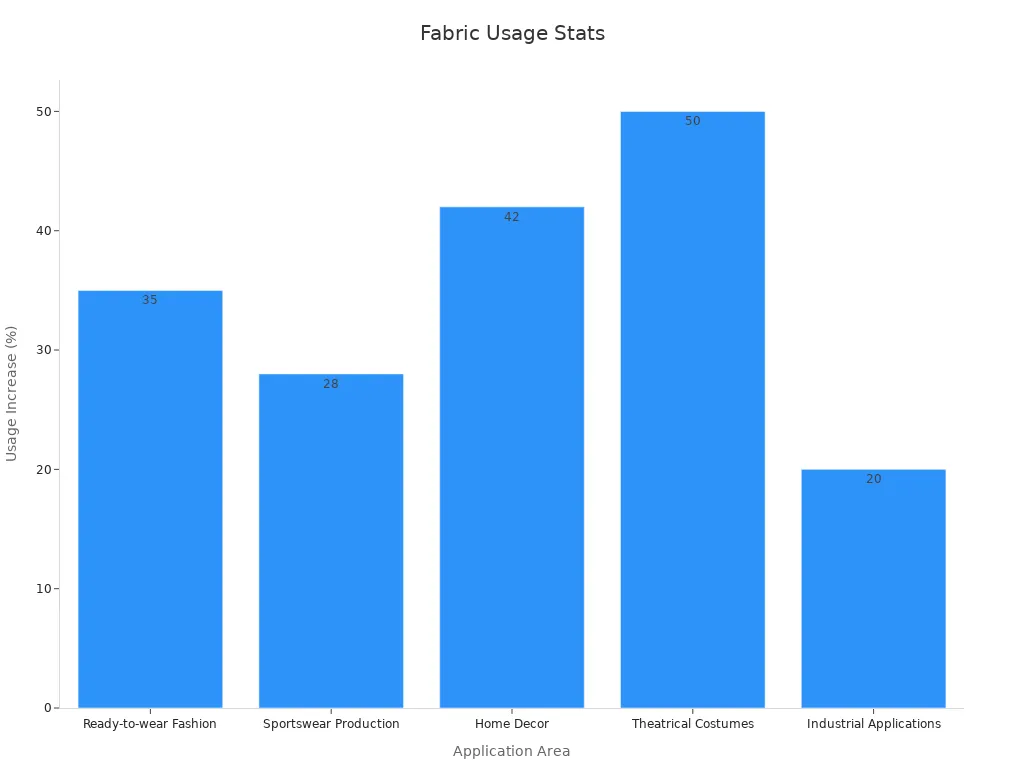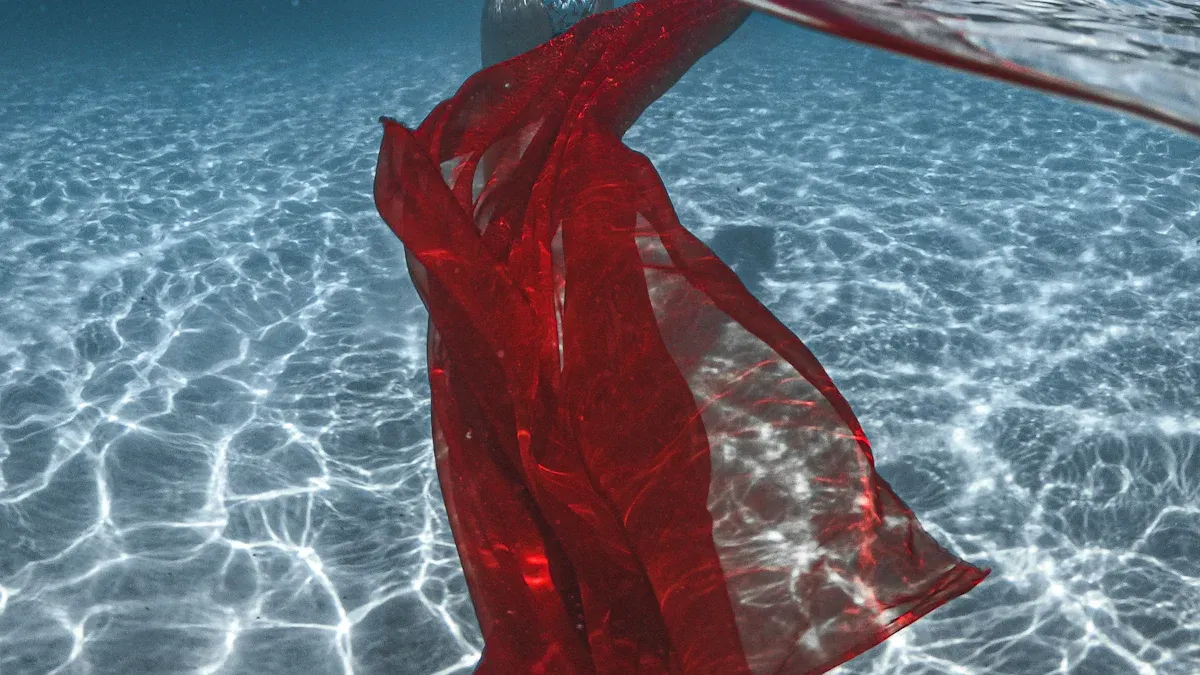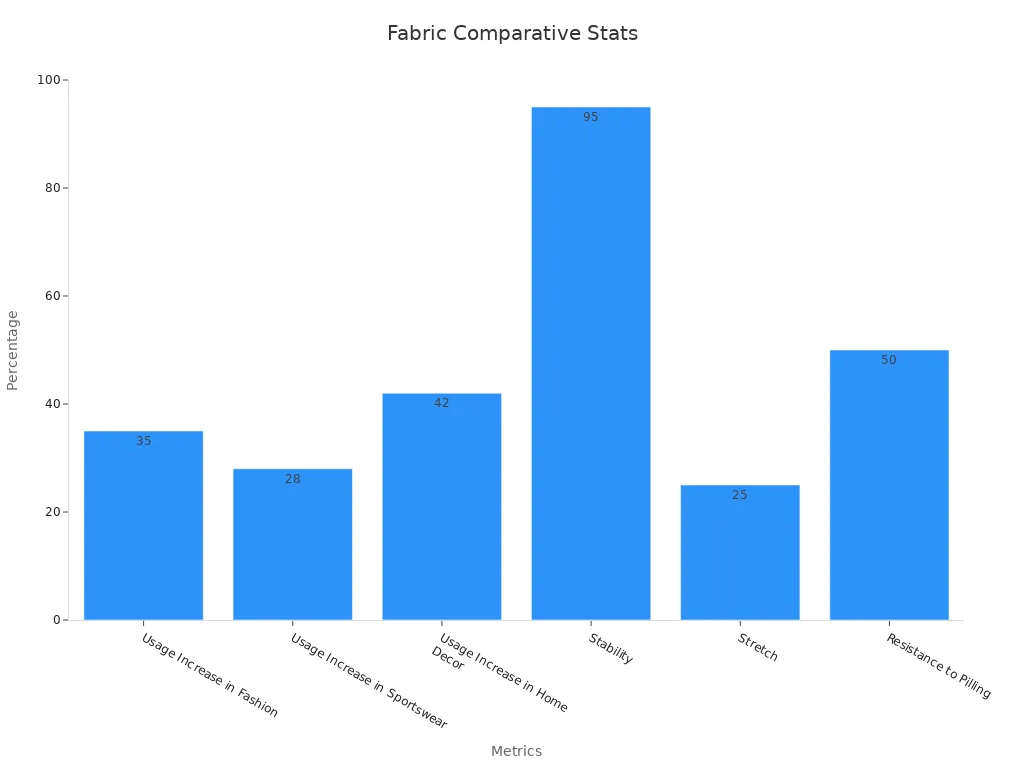
Polyester Spandex Scuba Fabric offers exceptional flexibility and structure. Designers and hobbyists recognize its value for fashion, sportswear, and home decor. Recent industry data shows strong usage growth across several creative sectors.

Key Takeaways
- Polyester Spandex Scuba Fabric combines stretch and structure, making it perfect for stylish, comfortable garments and durable accessories.
- This fabric works well for many projects like dresses, jackets, leggings, and home décor, offering easy handling for beginners and professionals alike.
- Using the right tools and care methods, such as sharp cutters, stretch needles, and gentle washing, helps keep your creations looking great and lasting longer.
Creative Project Ideas with Polyester Spandex Scuba Fabric

Fit-and-Flare Dress
A fit-and-flare dress showcases the unique qualities of Polyester Spandex Scuba Fabric. The fabric’s stretch allows for a comfortable bodice, while its structure creates a dramatic, flared skirt. Designers often choose this material for its ability to hold shape and resist wrinkles. The result is a dress that moves gracefully and maintains a crisp silhouette throughout the day.
Structured Skirt
A structured skirt benefits from the supportive nature of Polyester Spandex Scuba Fabric. The Brenda Dress Sewing Pattern, for example, recommends scuba or scuba crepe fabric for its ideal balance of stretch and structure.
- The fabric typically contains about 95% polyester and 5% spandex, providing both flexibility and form.
- Patterns designed for mid-weight knits with 25% stretch across and 20% stretch along the fabric ensure a flattering fit.
- Advanced beginners and experienced sewists find this fabric easy to handle, and consumer reviews praise the fit and construction of finished skirts.
Statement Jacket
A statement jacket made from this fabric stands out for its bold lines and modern appeal. The material’s thickness supports sharp collars, peplums, and dramatic sleeves. Designers appreciate how the fabric resists sagging and maintains its shape, even after repeated wear. This makes it a favorite for outerwear that needs to look polished and professional.
Fashionable Leggings
Polyester Spandex Scuba Fabric works well for leggings that require both stretch and opacity. The fabric hugs the body, providing support without restricting movement. Athletes and fashion enthusiasts alike value its moisture-wicking properties and smooth finish. The result is a pair of leggings that look sleek and feel comfortable during any activity.
Bold Crop Top
A bold crop top crafted from this fabric offers a modern, structured look. The material’s resilience allows for creative cutouts, high necklines, or sculpted sleeves. Designers often experiment with color-blocking and geometric shapes, knowing the fabric will hold its form. This versatility makes it a go-to choice for statement pieces in any wardrobe.
Modern Sweatshirt
A modern sweatshirt made from Polyester Spandex Scuba Fabric combines comfort with style. The fabric’s smooth surface and slight sheen elevate the classic sweatshirt silhouette. Wearers enjoy the warmth and flexibility, while the garment retains its shape after multiple washes. This makes it suitable for both casual and semi-formal settings.
Trendy Headband
A trendy headband benefits from the fabric’s stretch and recovery. The material stays snug without causing discomfort, making it ideal for active lifestyles. Crafters can easily sew or knot the fabric into various styles, from wide bands to twisted designs. The headband maintains its color and elasticity, even with frequent use.
Tote Bag
A tote bag constructed from this fabric offers durability and a modern look. The material’s thickness provides structure, allowing the bag to stand upright. Shoppers appreciate the easy-care nature of the fabric, which resists stains and wipes clean. The tote’s bold colors and crisp lines make it a practical and stylish accessory.
Decorative Pillow Cover
A decorative pillow cover made from Polyester Spandex Scuba Fabric adds a contemporary touch to home décor. The fabric’s stretch ensures a snug fit over pillow inserts, while its structure creates a smooth, tailored appearance. Homeowners enjoy the vibrant colors and easy maintenance, making these covers a popular choice for living rooms and bedrooms.
Costume Piece
Costume designers increasingly turn to this fabric for theatrical and cosplay applications. The United States Institute for Theatre Technology reports a 50% rise in the use of scuba crepe fabric for costumes over the past five years.
- Designers value the fabric’s durability and ease of care, which suit repeated performances and quick changes.
- The material holds vibrant colors and maintains its shape under stage lighting.
- The blend of polyester and spandex provides both structure and stretch, enhancing comfort and fit for performers.
Tip: When creating costume pieces, choose bright colors and bold shapes to take full advantage of the fabric’s unique properties.
Project Details for Each Idea
Project Overview
Each creative project benefits from the unique properties of Polyester Spandex Scuba Fabric. Designers use this material to craft garments and accessories that require both structure and flexibility. The fabric adapts well to a variety of patterns, from fitted dresses to bold jackets and even home décor items. Its versatility supports both beginner and advanced sewing projects.
Why Polyester Spandex Scuba Fabric Works
- The blend of polyester and spandex provides a balance of structure and stretch.
- The fabric stretches 25-30% with excellent recovery, allowing garments to move with the wearer while maintaining their shape.
- Durability stands out, as studies show the fabric resists pilling, fading, and wear, even after 50 wash cycles.
- Moisture-wicking and breathability keep users comfortable, making it ideal for activewear.
- The fabric absorbs dye well, resulting in vibrant, long-lasting colors.
- Its medium weight and structured drape support a wide range of applications, from fashion to home décor.
Note: The fabric’s resistance to chemicals, abrasion, and UV rays expands its use beyond apparel, making it suitable for technical and industrial projects.
Tips for Success
Sewists achieve the best results by following expert advice. Polyester Spandex Scuba Fabric typically contains about 95% polyester and 5% spandex, offering strong stretch and durability. For tight-fitting projects, the fabric’s 30-50% horizontal stretch ensures comfort and shape retention. Water resistance and moisture-wicking properties help keep wearers dry, especially in sportswear. Selecting the right needle and using a stretch stitch on the sewing machine prevents skipped stitches and puckering. Pre-washing the fabric and testing stitches on a scrap piece can further improve project outcomes.
Quick Tips for Working with Polyester Spandex Scuba Fabric
Cutting Techniques
Sharp fabric shears or a rotary cutter provide clean edges when working with Polyester Spandex Scuba Fabric. Pattern weights help prevent shifting, as the fabric’s stretch can distort shapes. Many professionals recommend cutting single layers for greater accuracy. Mark notches with tailor’s chalk or washable markers, since pins may leave impressions on the fabric’s surface.
Sewing Machine Settings
Selecting the right machine settings ensures smooth seams. A stretch or narrow zigzag stitch allows the fabric to move without breaking threads. The following table summarizes recommended settings for similar stretch fabrics:
| Fabric Type | Tension Setting | Needle Type | Special Considerations |
|---|---|---|---|
| Spandex/Lycra blends | 2 – 3 | Stretch or Ballpoint | Use stretch stitch or zigzag stitch |
Sewists should test tension on a scrap piece, adjusting in small increments until stitches lie flat.
Choosing Needles and Thread
A stretch or ballpoint needle (size 75/11) reduces skipped stitches and prevents snags. Polyester thread offers strength and flexibility, matching the fabric’s performance. For extra stretch, wooly nylon thread in the bobbin works well.
Finishing Seams
Scuba knit does not fray, so finishing seams is optional. Many designers leave raw hems for a modern look. When pressing seams, use a pressing cloth and low heat. Gently flatten seams with fingers or a tailor’s clapper to avoid damaging the fabric.
Care and Maintenance
Proper care extends the life of garments. Machine wash in cold water on a delicate cycle with mild detergent. Turn items inside out before washing. Air dry on padded hangers or flat, away from direct sunlight. Iron on low heat with a cloth barrier or use steaming. Store on padded hangers or with acid-free tissue paper to maintain shape.
Tip: Improper home care causes about 25% of garment damage. Professional cleaning helps preserve delicate or heavily soiled items.
Designers and hobbyists continue to choose this fabric for its versatility and performance. Recent data shows significant growth in usage across fashion, sportswear, and home decor. The table and chart below highlight its comparative advantages in stability, stretch, and durability.
| Metric | Polyester Spandex Scuba Fabric (Scuba Crepe) | Comparison Benchmark | Comparative Advantage |
|---|---|---|---|
| Usage Increase in Fashion | 35% increase in ready-to-wear collections | N/A | Indicates growing preference |
| Usage Increase in Sportswear | 28% increase | N/A | Shows expanding application |
| Usage Increase in Home Decor | 42% increase | N/A | Demonstrates versatility |
| Stability | 95% more stable | Traditional crepe fabric | Superior structural integrity |
| Stretch | Up to 25% more stretch | Ponte knit | Enhanced flexibility and comfort |
| Resistance to Pilling | 50% more resistant | Jersey knit | Improved durability and longevity |

Try a new project and experience the benefits of this innovative material.
FAQ
What types of garments work best with polyester spandex scuba fabric?
Designers often select this fabric for dresses, skirts, jackets, and leggings. Its stretch and structure support both fitted and sculpted silhouettes.
Can beginners sew with polyester spandex scuba fabric?
Yes. Beginners find this fabric easy to handle. The material resists fraying and holds its shape, making it suitable for entry-level sewing projects.
How should users care for items made from this fabric?
Machine wash in cold water. Air dry flat or on padded hangers. Avoid high heat when ironing. Proper care preserves color and fabric integrity.
Post time: Jun-27-2025